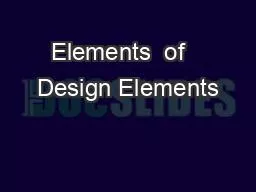/


of Art The elements of art are the building blocks used by artists to create a work of art Line S h a p e Forms Spa ce Colo ID: 802307
Download The PPT/PDF document "Elements of Design Elements" is the property of its rightful owner. Permission is granted to download and print the materials on this web site for personal, non-commercial use only, and to display it on your personal computer provided you do not modify the materials and that you retain all copyright notices contained in the materials. By downloading content from our website, you accept the terms of this agreement.
Slide1
Elements
of
Design
Slide2Elements
of
Art
The
elements
of
art
are
the building
blocks
used
by
artists
to
create
a
work
of
art.
Line
ShapeForms
Spa
ce
Colo
u
r
T
e
x
tu
r
e
Slide3L
i
n
e
A
mark
with
greater
length
than
width
Lines
c
an
be
horizont
al,
vertic
al,
or diagonal; straight or curved; thick or
thin
Slide4S
h
a
p
e
A
closed
line
Shapes
c
an
be
geometric
Squares
and
circles
Shapes c an be organic
Free-form
or
natural
shapes
Shapes
are
flat
and
c
an
express
length
and width
Slide5F
o
r
m
s
Three-dimension
al shapes
expressing
length,
width,
and
depth
Balls,
cylin
ders,
boxes,
and
pyramids
are
forms
Slide6Spa
ce
The
area
between
and
around
objects.
The
spa
ce
around
objects
is
often
c
alle
d
negative
spa ce;
negative
spa
ce
has
shape.
Spa
ce
c
an
also
refer
to
the
feeling of depth.
Slide7Co
l
o
u
r
Light
reflected
off
of
objects
Colo
u
r
has
three
main
chara
cteristics:
Hue: the name of the colo
u
r
,
such
as
red,
green, blue,
etc.
Value:
how
light
or
dark
it is
Intensity: how bright
or dull it is
Slide8Colo
u
r
Cont.
White
is
pure
light;
black
is
the
absence
of
light.
Primary
colo
u
rs
are
the
only true
colours (red, blue, and yellow)Secondary colours are two primary colours mixed together (green, orange, violet)
Slide9Colo
u
r
Cont.
Intermediate
colo
u
rs
(tertiary):
made
by
mixing
a
prim
ary
and
secondary
colo
u
r
together (yellow green, blue green, and blue violet).
Slide10Colo
u
r
Cont.
Complementary
colo
u
rs
:
loc
ated
dire
ctly
a
cross
from
e
ch
other
on
the color wheel. Complementary
pairs
contrast
bec
ause
they
share
no
common
colors
Red
and
green
are
complements, because green is made
of blue and
yellow When complementary colours are mixed together, they neutralize each
other to make
brown.
Slide11Colo
u
r
Cont.
Slide12T
e
x
tu
r
e
Surf
a
ce
quality
that
c
an
be
seen
and
felt
Textures
c
an
be rough or smooth, soft or hard
Textures
do
not
always
feel
the
way they
look;
A
drawing
of
a
porcupine may look prickly, but
if you touch
the drawing, the paper is still smooth.
Slide13Principles
of
Design
Slide14Principles
of
Design
The
prin
ciples
of
design
describ
e
the
ways
that
artists use
the
elements
of
art
in a
work
of
art.BalanceEmphasisMovem
e
nt
Pattern
R
ep
e
t
i
t
i
o
n
Pro
portion
RhythmUnity
Slide15Balance
Distribution
of
the
visu
al
weight
of
objects,
colo
u
rs
,
texture,
and
spa
ce.
Symmetrical
balance
(formal):
the elements used on one sid
e
of the
design
are
similar
to
those
on
the
other
side
Asymmetrical
balance
(informal): the sid es are different
but still
look balanced. Radial balance: the elements are arranged around a central point and may be
similar.
Slide16Balance
Asymmetric
al
(Informal)
Balance
Symmetric
al(Formal)
Balance
Radial
Balance
Slide17E
m
ph
a
sis
Part
of
the
design
that
c
atches
the
viewer’s
attention
Usually
the
artist
will
make
one
area stand out by contrasting it with other
areas.
The
area
could be
different
in
size,
color,
texture,
shape,
etc.
Slide18Movement
The
path
the
viewer’s
eye
takes
through
the
work
of
art,
often
to
foc
al
areas
Such
movement
c
an be directed along
lines,
edges,
shape,
and
color
Slide19P
a
t
t
e
r
n
The
repeating
of
an
object
or
symbol
all
over
the
work
of
art
Slide20R
ep
e
t
i
t
i
o
n
Works
with
pattern
to
make
the
work
of
art
seem
a
ctive
The repetition of elements of design creates unity within the work of
art
Slide21Proportion
The
feeling of
unity
created
when
all
parts
(sizes,
amounts,
or
number)
relate
well
with
ea
ch
other
Size
of
objects in relation to other objects
Slide22R
hyt
h
m
When
one
or
more
elements
of
design
are
used
repeatedly
to
create
a
feeling of
organize
d
movement
To keep rhythm exciting and a
ctive,
variety
is
essential
Slide23U
n
i
t
y
The
feeling of
harmony
between
all
parts
of
the
work
of
art,
which
creates
a
sense
of
completeness Relationship of objects to one
another
and
to
the
design